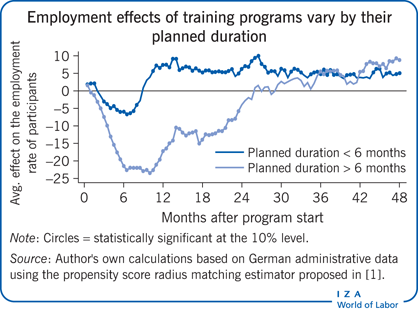Elevator pitch
Activation programs, such as job search assistance, training, or work experience programs for unemployed workers, typically initially produce negative employment effects. These so-called “lock-in effects” occur because participants spend less time and effort on job search activities than non-participants. Lock-in effects need to be offset by sufficiently large post-participation employment or earnings for the programs to be cost-effective. They represent key indirect costs that are often more important than direct program costs. The right timing and targeting of these programs can improve their cost-effectiveness by reducing lock-in effects.
Key findings
Pros
Activation programs can improve the employment prospects and earnings of participants.
Higher expected post-program effects make participation more desirable.
The human capital investment associated with a program increases with program duration.
The earlier in the unemployment spell the program takes place the earlier possible positive employment effects can occur.
Cons
Activation programs divert time and effort away from job search.
As the expected post-program effects increase, it becomes more attractive to complete the program than to search for a job, which increases the magnitude of lock-in effects.
Incentives to engage in an intense job search decrease with the length of the program, especially during its early stages.
Starting programs early in the unemployment spell makes it more likely that participants will forego good employment chances.
